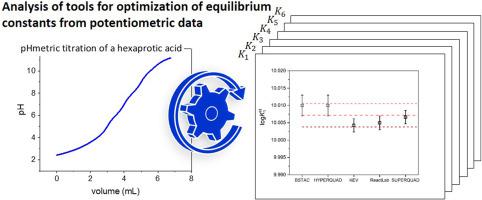当前位置:
X-MOL 学术
›
Anal. Chim. Acta
›
论文详情
Our official English website, www.x-mol.net, welcomes your feedback! (Note: you will need to create a separate account there.)
A tutorial on potentiometric data processing. Analysis of software for optimization of protonation constants
Analytica Chimica Acta ( IF 6.2 ) Pub Date : 2024-03-17 , DOI: 10.1016/j.aca.2024.342476 Silvia Berto , Salvador Blasco , Lorenzo Castellino , Aleksandar Cvetkovski , Concetta De Stefano , Sofia Gama , Enrique García-España , Petr Hermann , Gabriele Lando , Matteo Marafante , Michel Meyer , Winfried Plass , Lauryn Quinodoz , Demetrio Milea
Analytica Chimica Acta ( IF 6.2 ) Pub Date : 2024-03-17 , DOI: 10.1016/j.aca.2024.342476 Silvia Berto , Salvador Blasco , Lorenzo Castellino , Aleksandar Cvetkovski , Concetta De Stefano , Sofia Gama , Enrique García-España , Petr Hermann , Gabriele Lando , Matteo Marafante , Michel Meyer , Winfried Plass , Lauryn Quinodoz , Demetrio Milea

|
Defining the distribution of the chemical species in a multicomponent system is a task of great importance with applications in many fields. To clarify the identity and the abundance of the species that can be formed by the interaction of the components of a solution, it is fundamental to know the formation constants of those species. The determination of equilibrium constants is mainly performed through the analysis of experimental data obtained by different instrumental techniques. Among them, potentiometry is the elective technique for this purpose. As such, a survey was run within the NECTAR COST Action – Network for Equilibria and Chemical Thermodynamics Advanced Research, to identify the most used software for the analysis of potentiometric data and to highlight their strengths and weaknesses. The features and the calculation processes of each software were analyzed and rationalized, and a simulated titration dataset of a hypothetic hexaprotic acid was processed by each software to compare and discuss the optimized protonation constants. Moreover, further data analysis was also carried out on the original dataset including some systematic errors from different sources, as some calibration parameters, the total analytical concentration of reagents and ionic strength variations during titrations, to evaluate their impact on the refined parameters. Results showed that differences on the protonation constants estimated by the tested software are not significant, while some of the considered systematic errors affect results. Overall, it emerged that software commonly used suffer from many limitations, highlighting the urgency of new dedicated and modern tools. In this context, some guidelines for data generation and treatment are also given.
中文翻译:

电位数据处理教程。质子化常数优化软件分析
定义多组分系统中化学物质的分布是一项非常重要的任务,在许多领域都有应用。为了澄清溶液成分相互作用所形成的物质的特性和丰度,了解这些物质的形成常数至关重要。平衡常数的测定主要通过对不同仪器技术获得的实验数据进行分析来进行。其中,电位测定法是用于此目的的可选技术。因此,NECTAR COST Action – 平衡和化学热力学高级研究网络进行了一项调查,以确定最常用的电位数据分析软件,并强调其优点和缺点。对各软件的特点和计算过程进行了分析和合理化,并通过各软件处理了假设六质子酸的模拟滴定数据集,对优化后的质子化常数进行了比较和讨论。此外,还对原始数据集进行了进一步的数据分析,包括来自不同来源的一些系统误差,如一些校准参数、试剂的总分析浓度和滴定过程中的离子强度变化,以评估它们对精化参数的影响。结果表明,测试软件估计的质子化常数差异并不显着,而一些考虑的系统误差会影响结果。总体而言,常用的软件存在许多局限性,凸显了新的专用现代工具的紧迫性。在此背景下,还给出了一些数据生成和处理的指南。
更新日期:2024-03-17
中文翻译:

电位数据处理教程。质子化常数优化软件分析
定义多组分系统中化学物质的分布是一项非常重要的任务,在许多领域都有应用。为了澄清溶液成分相互作用所形成的物质的特性和丰度,了解这些物质的形成常数至关重要。平衡常数的测定主要通过对不同仪器技术获得的实验数据进行分析来进行。其中,电位测定法是用于此目的的可选技术。因此,NECTAR COST Action – 平衡和化学热力学高级研究网络进行了一项调查,以确定最常用的电位数据分析软件,并强调其优点和缺点。对各软件的特点和计算过程进行了分析和合理化,并通过各软件处理了假设六质子酸的模拟滴定数据集,对优化后的质子化常数进行了比较和讨论。此外,还对原始数据集进行了进一步的数据分析,包括来自不同来源的一些系统误差,如一些校准参数、试剂的总分析浓度和滴定过程中的离子强度变化,以评估它们对精化参数的影响。结果表明,测试软件估计的质子化常数差异并不显着,而一些考虑的系统误差会影响结果。总体而言,常用的软件存在许多局限性,凸显了新的专用现代工具的紧迫性。在此背景下,还给出了一些数据生成和处理的指南。



























 京公网安备 11010802027423号
京公网安备 11010802027423号